WOU TBE208/05 Quantity Surveying Practice TMA 1 - Semester 1, 2019
VerifiedAdded on 2023/04/24
|12
|1604
|75
Homework Assignment
AI Summary
This assignment solution provides a comprehensive overview of quantity surveying practice, addressing key concepts from the RIBA plan of work to tender documents. The solution begins by explaining the RIBA plan of work, outlining its various stages from strategic definition to the in-use stage, and detailing the responsibilities and production requirements at each phase. The assignment then delves into the roles of building team members, including the employer, architect, quantity surveyor, consulting engineers, contractor, project manager, and clerk of works. Furthermore, the solution explores tender documents, including drawings, bills of quantities, specifications, conditions of contract, schedules, and schedule of rates, providing detailed explanations and examples for each. The document references key texts on quantity surveying, offering a well-structured and informative resource for students studying this subject.
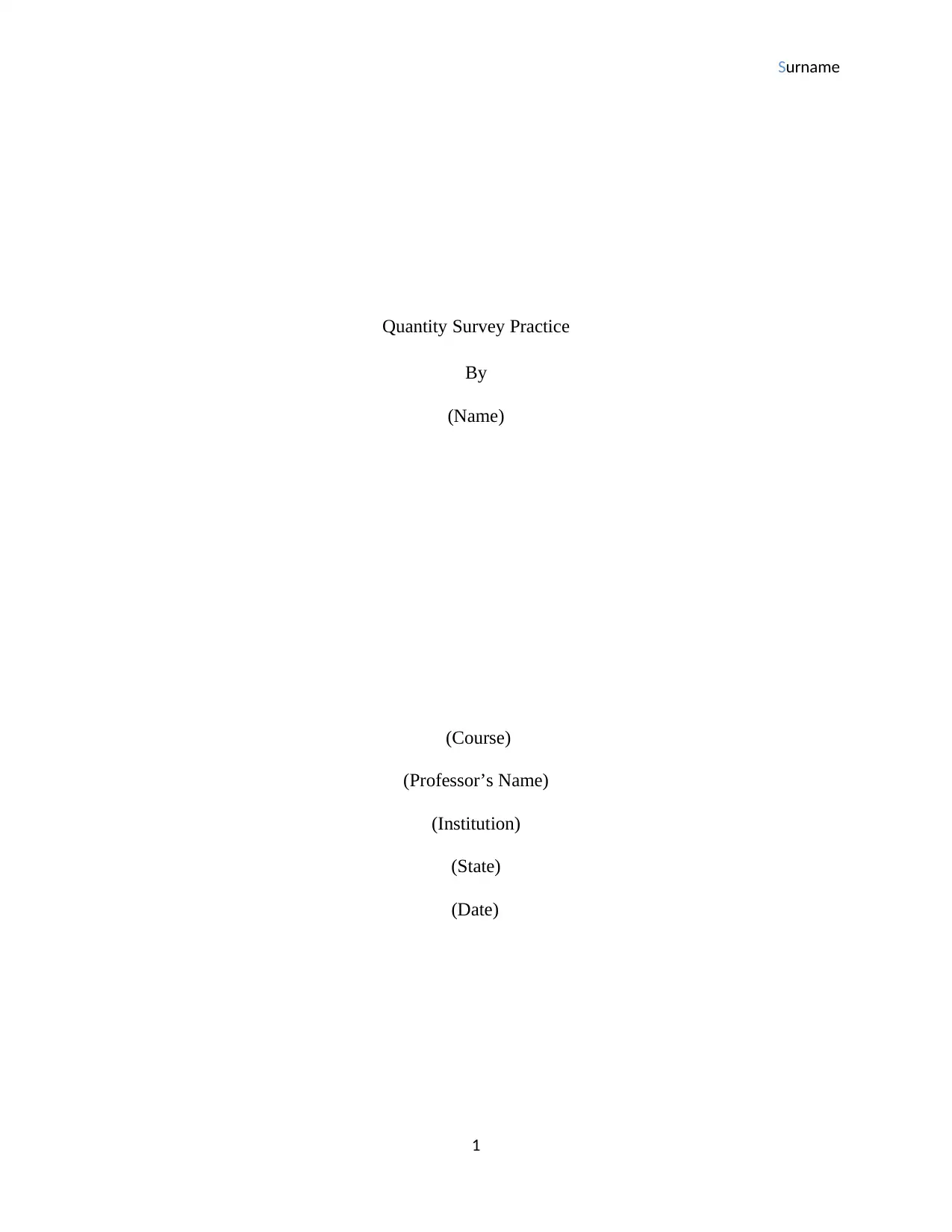
Surname
Quantity Survey Practice
By
(Name)
(Course)
(Professor’s Name)
(Institution)
(State)
(Date)
1
Quantity Survey Practice
By
(Name)
(Course)
(Professor’s Name)
(Institution)
(State)
(Date)
1
Paraphrase This Document
Need a fresh take? Get an instant paraphrase of this document with our AI Paraphraser
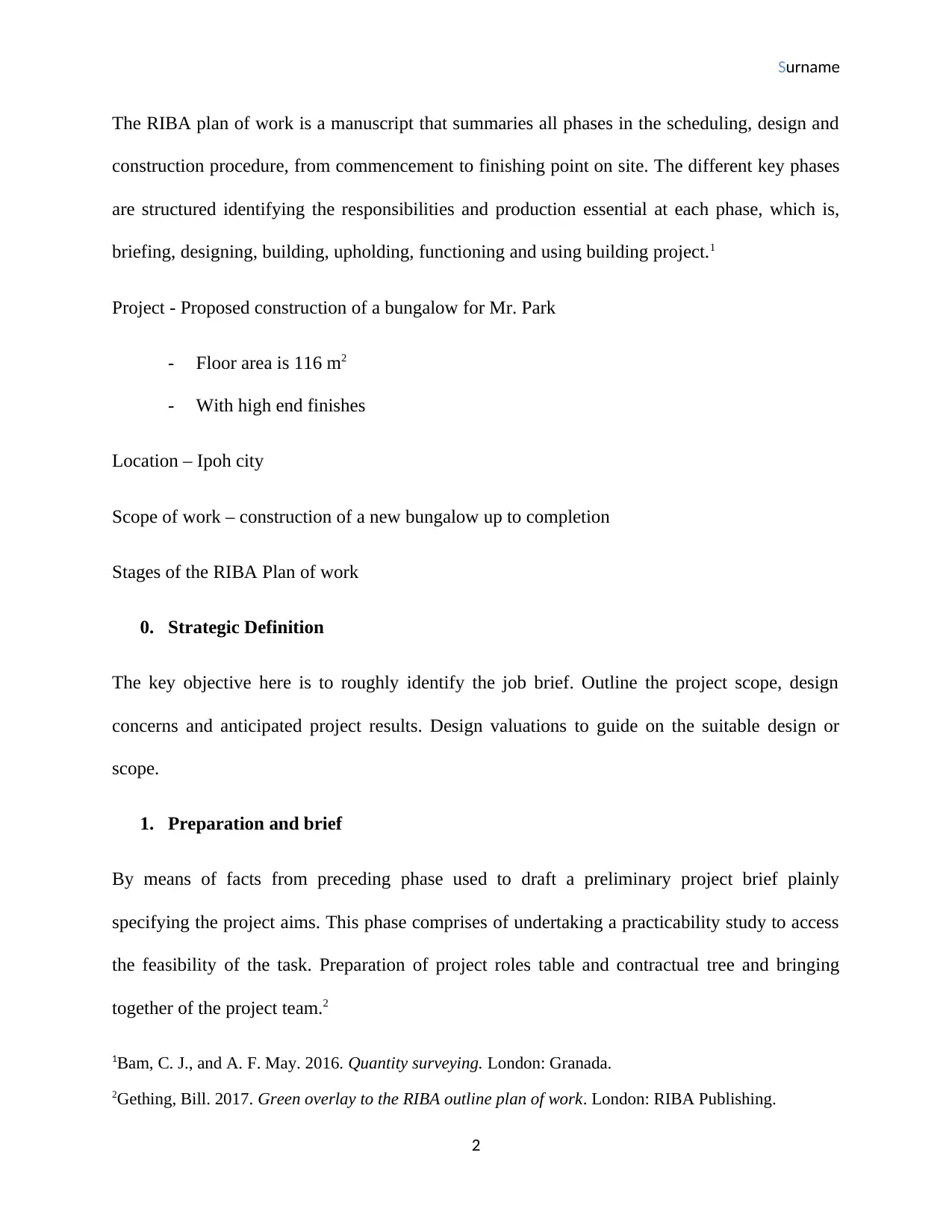
Surname
The RIBA plan of work is a manuscript that summaries all phases in the scheduling, design and
construction procedure, from commencement to finishing point on site. The different key phases
are structured identifying the responsibilities and production essential at each phase, which is,
briefing, designing, building, upholding, functioning and using building project.1
Project - Proposed construction of a bungalow for Mr. Park
- Floor area is 116 m2
- With high end finishes
Location – Ipoh city
Scope of work – construction of a new bungalow up to completion
Stages of the RIBA Plan of work
0. Strategic Definition
The key objective here is to roughly identify the job brief. Outline the project scope, design
concerns and anticipated project results. Design valuations to guide on the suitable design or
scope.
1. Preparation and brief
By means of facts from preceding phase used to draft a preliminary project brief plainly
specifying the project aims. This phase comprises of undertaking a practicability study to access
the feasibility of the task. Preparation of project roles table and contractual tree and bringing
together of the project team.2
1Bam, C. J., and A. F. May. 2016. Quantity surveying. London: Granada.
2Gething, Bill. 2017. Green overlay to the RIBA outline plan of work. London: RIBA Publishing.
2
The RIBA plan of work is a manuscript that summaries all phases in the scheduling, design and
construction procedure, from commencement to finishing point on site. The different key phases
are structured identifying the responsibilities and production essential at each phase, which is,
briefing, designing, building, upholding, functioning and using building project.1
Project - Proposed construction of a bungalow for Mr. Park
- Floor area is 116 m2
- With high end finishes
Location – Ipoh city
Scope of work – construction of a new bungalow up to completion
Stages of the RIBA Plan of work
0. Strategic Definition
The key objective here is to roughly identify the job brief. Outline the project scope, design
concerns and anticipated project results. Design valuations to guide on the suitable design or
scope.
1. Preparation and brief
By means of facts from preceding phase used to draft a preliminary project brief plainly
specifying the project aims. This phase comprises of undertaking a practicability study to access
the feasibility of the task. Preparation of project roles table and contractual tree and bringing
together of the project team.2
1Bam, C. J., and A. F. May. 2016. Quantity surveying. London: Granada.
2Gething, Bill. 2017. Green overlay to the RIBA outline plan of work. London: RIBA Publishing.
2
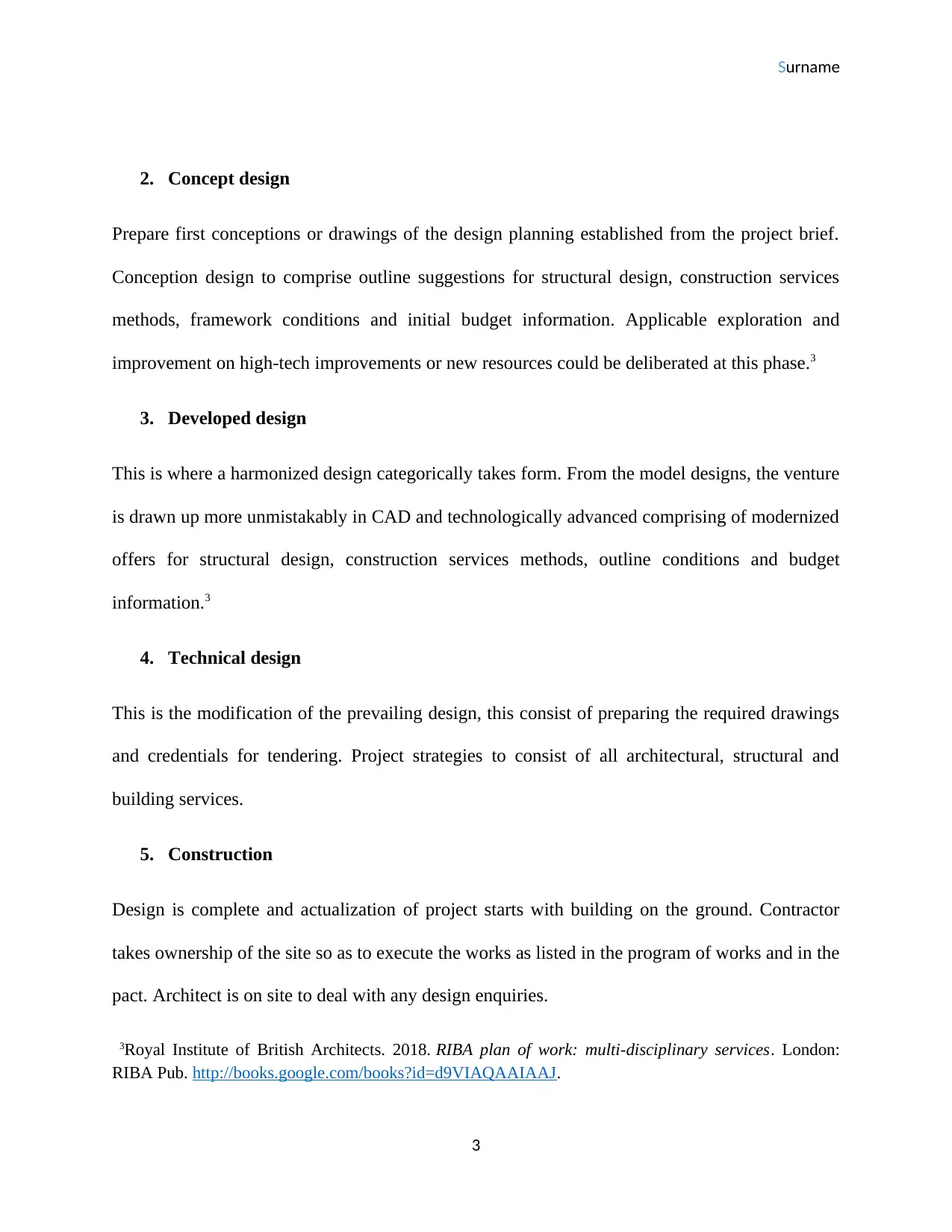
Surname
2. Concept design
Prepare first conceptions or drawings of the design planning established from the project brief.
Conception design to comprise outline suggestions for structural design, construction services
methods, framework conditions and initial budget information. Applicable exploration and
improvement on high-tech improvements or new resources could be deliberated at this phase.3
3. Developed design
This is where a harmonized design categorically takes form. From the model designs, the venture
is drawn up more unmistakably in CAD and technologically advanced comprising of modernized
offers for structural design, construction services methods, outline conditions and budget
information.3
4. Technical design
This is the modification of the prevailing design, this consist of preparing the required drawings
and credentials for tendering. Project strategies to consist of all architectural, structural and
building services.
5. Construction
Design is complete and actualization of project starts with building on the ground. Contractor
takes ownership of the site so as to execute the works as listed in the program of works and in the
pact. Architect is on site to deal with any design enquiries.
3Royal Institute of British Architects. 2018. RIBA plan of work: multi-disciplinary services. London:
RIBA Pub. http://books.google.com/books?id=d9VIAQAAIAAJ.
3
2. Concept design
Prepare first conceptions or drawings of the design planning established from the project brief.
Conception design to comprise outline suggestions for structural design, construction services
methods, framework conditions and initial budget information. Applicable exploration and
improvement on high-tech improvements or new resources could be deliberated at this phase.3
3. Developed design
This is where a harmonized design categorically takes form. From the model designs, the venture
is drawn up more unmistakably in CAD and technologically advanced comprising of modernized
offers for structural design, construction services methods, outline conditions and budget
information.3
4. Technical design
This is the modification of the prevailing design, this consist of preparing the required drawings
and credentials for tendering. Project strategies to consist of all architectural, structural and
building services.
5. Construction
Design is complete and actualization of project starts with building on the ground. Contractor
takes ownership of the site so as to execute the works as listed in the program of works and in the
pact. Architect is on site to deal with any design enquiries.
3Royal Institute of British Architects. 2018. RIBA plan of work: multi-disciplinary services. London:
RIBA Pub. http://books.google.com/books?id=d9VIAQAAIAAJ.
3
⊘ This is a preview!⊘
Do you want full access?
Subscribe today to unlock all pages.

Trusted by 1+ million students worldwide
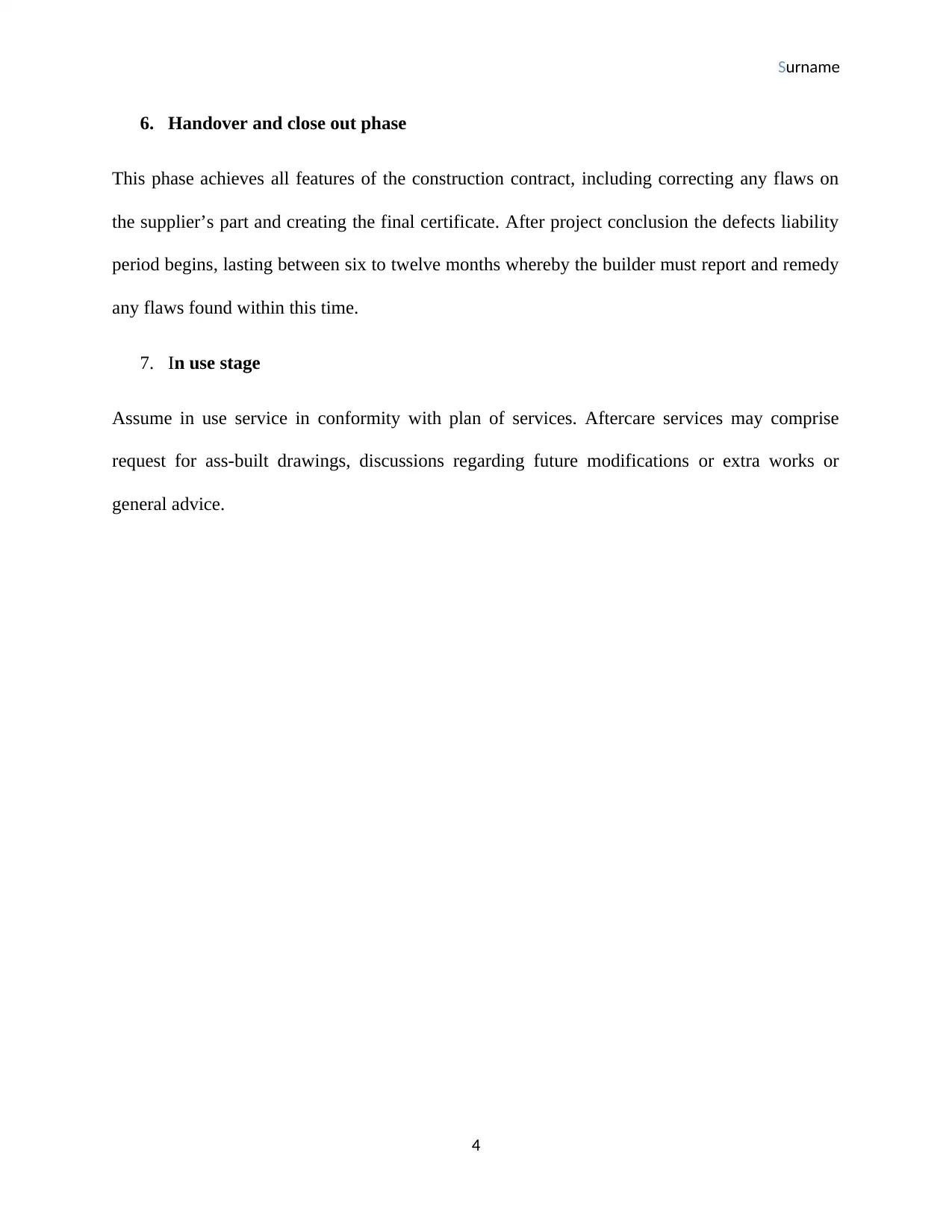
Surname
6. Handover and close out phase
This phase achieves all features of the construction contract, including correcting any flaws on
the supplier’s part and creating the final certificate. After project conclusion the defects liability
period begins, lasting between six to twelve months whereby the builder must report and remedy
any flaws found within this time.
7. In use stage
Assume in use service in conformity with plan of services. Aftercare services may comprise
request for ass-built drawings, discussions regarding future modifications or extra works or
general advice.
4
6. Handover and close out phase
This phase achieves all features of the construction contract, including correcting any flaws on
the supplier’s part and creating the final certificate. After project conclusion the defects liability
period begins, lasting between six to twelve months whereby the builder must report and remedy
any flaws found within this time.
7. In use stage
Assume in use service in conformity with plan of services. Aftercare services may comprise
request for ass-built drawings, discussions regarding future modifications or extra works or
general advice.
4
Paraphrase This Document
Need a fresh take? Get an instant paraphrase of this document with our AI Paraphraser
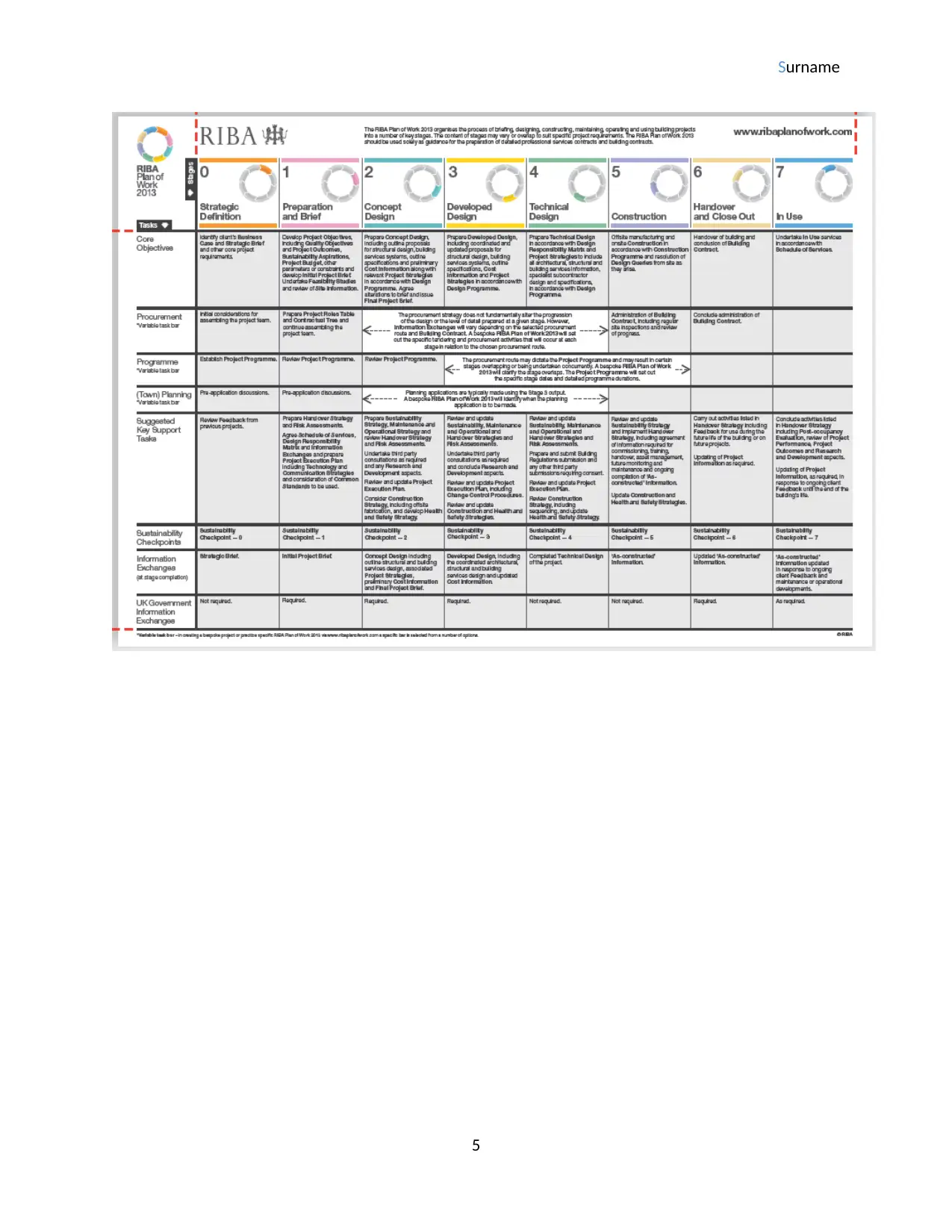
Surname
5
5
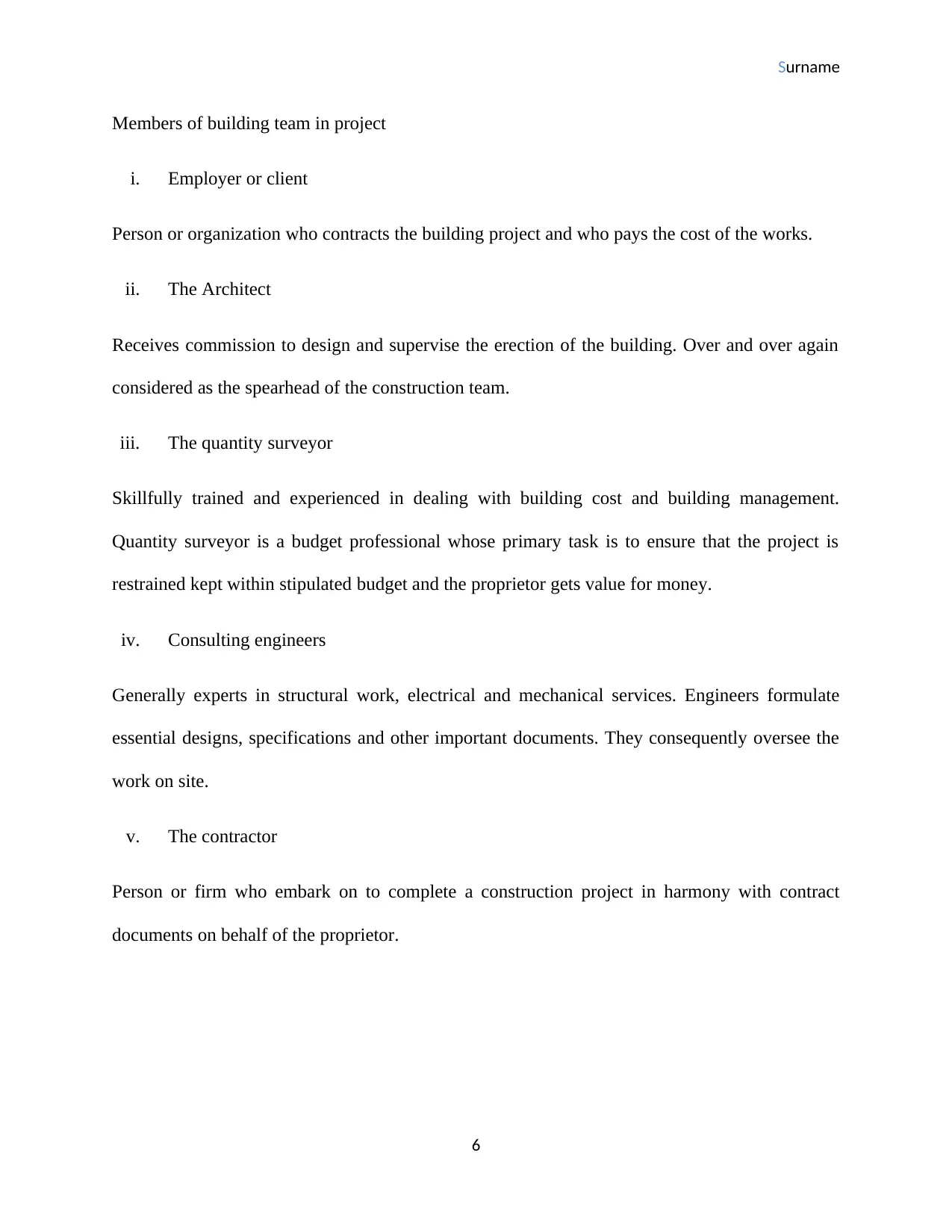
Surname
Members of building team in project
i. Employer or client
Person or organization who contracts the building project and who pays the cost of the works.
ii. The Architect
Receives commission to design and supervise the erection of the building. Over and over again
considered as the spearhead of the construction team.
iii. The quantity surveyor
Skillfully trained and experienced in dealing with building cost and building management.
Quantity surveyor is a budget professional whose primary task is to ensure that the project is
restrained kept within stipulated budget and the proprietor gets value for money.
iv. Consulting engineers
Generally experts in structural work, electrical and mechanical services. Engineers formulate
essential designs, specifications and other important documents. They consequently oversee the
work on site.
v. The contractor
Person or firm who embark on to complete a construction project in harmony with contract
documents on behalf of the proprietor.
6
Members of building team in project
i. Employer or client
Person or organization who contracts the building project and who pays the cost of the works.
ii. The Architect
Receives commission to design and supervise the erection of the building. Over and over again
considered as the spearhead of the construction team.
iii. The quantity surveyor
Skillfully trained and experienced in dealing with building cost and building management.
Quantity surveyor is a budget professional whose primary task is to ensure that the project is
restrained kept within stipulated budget and the proprietor gets value for money.
iv. Consulting engineers
Generally experts in structural work, electrical and mechanical services. Engineers formulate
essential designs, specifications and other important documents. They consequently oversee the
work on site.
v. The contractor
Person or firm who embark on to complete a construction project in harmony with contract
documents on behalf of the proprietor.
6
⊘ This is a preview!⊘
Do you want full access?
Subscribe today to unlock all pages.

Trusted by 1+ million students worldwide
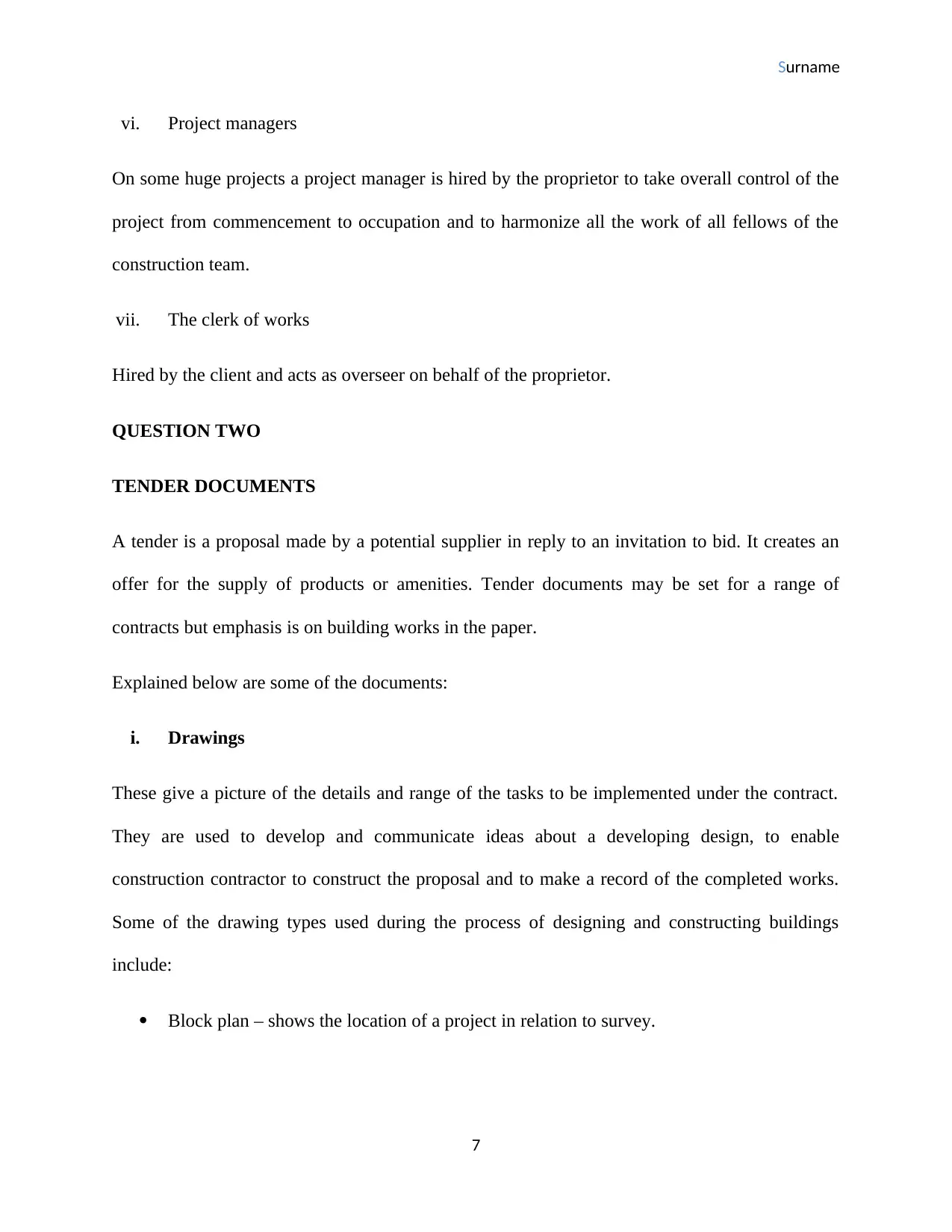
Surname
vi. Project managers
On some huge projects a project manager is hired by the proprietor to take overall control of the
project from commencement to occupation and to harmonize all the work of all fellows of the
construction team.
vii. The clerk of works
Hired by the client and acts as overseer on behalf of the proprietor.
QUESTION TWO
TENDER DOCUMENTS
A tender is a proposal made by a potential supplier in reply to an invitation to bid. It creates an
offer for the supply of products or amenities. Tender documents may be set for a range of
contracts but emphasis is on building works in the paper.
Explained below are some of the documents:
i. Drawings
These give a picture of the details and range of the tasks to be implemented under the contract.
They are used to develop and communicate ideas about a developing design, to enable
construction contractor to construct the proposal and to make a record of the completed works.
Some of the drawing types used during the process of designing and constructing buildings
include:
Block plan – shows the location of a project in relation to survey.
7
vi. Project managers
On some huge projects a project manager is hired by the proprietor to take overall control of the
project from commencement to occupation and to harmonize all the work of all fellows of the
construction team.
vii. The clerk of works
Hired by the client and acts as overseer on behalf of the proprietor.
QUESTION TWO
TENDER DOCUMENTS
A tender is a proposal made by a potential supplier in reply to an invitation to bid. It creates an
offer for the supply of products or amenities. Tender documents may be set for a range of
contracts but emphasis is on building works in the paper.
Explained below are some of the documents:
i. Drawings
These give a picture of the details and range of the tasks to be implemented under the contract.
They are used to develop and communicate ideas about a developing design, to enable
construction contractor to construct the proposal and to make a record of the completed works.
Some of the drawing types used during the process of designing and constructing buildings
include:
Block plan – shows the location of a project in relation to survey.
7
Paraphrase This Document
Need a fresh take? Get an instant paraphrase of this document with our AI Paraphraser
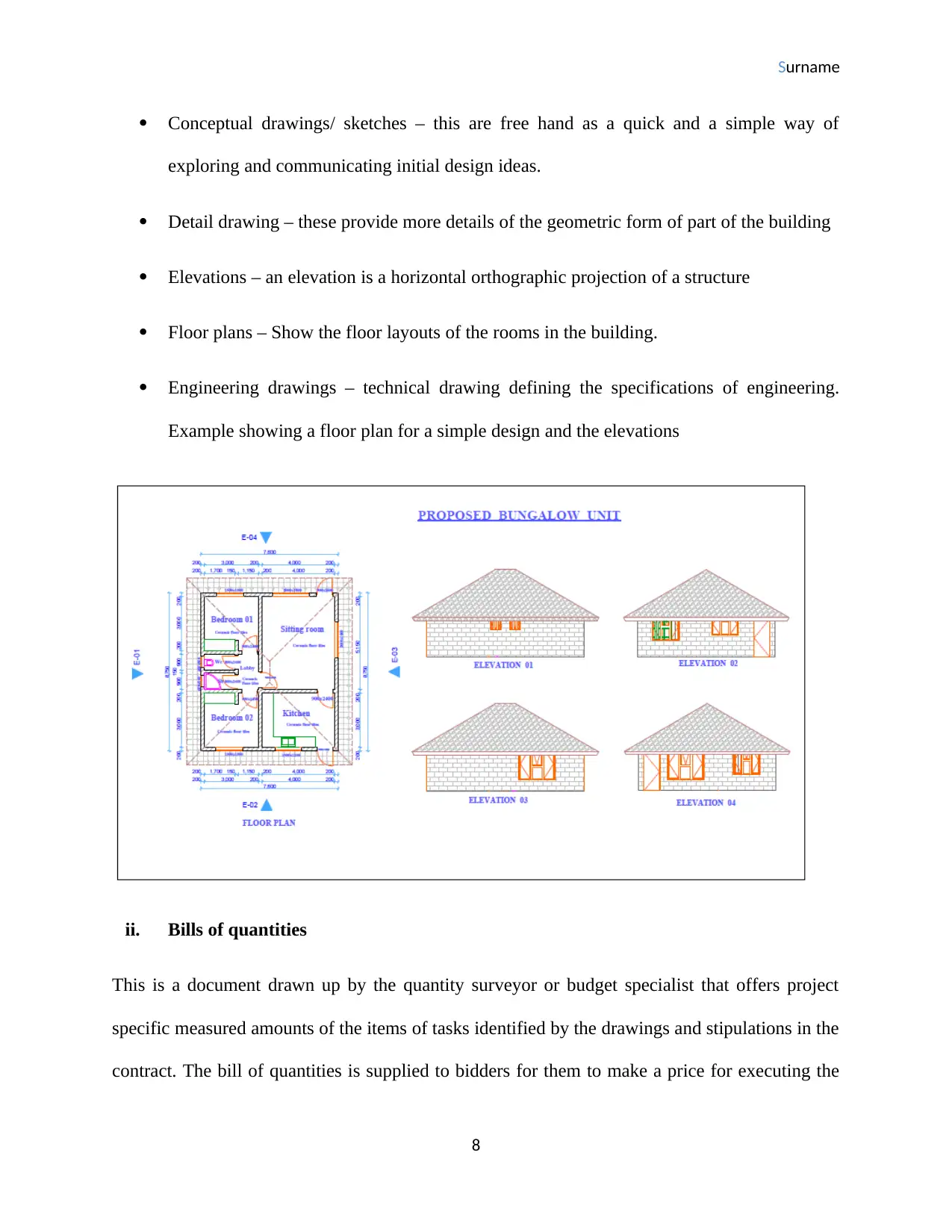
Surname
Conceptual drawings/ sketches – this are free hand as a quick and a simple way of
exploring and communicating initial design ideas.
Detail drawing – these provide more details of the geometric form of part of the building
Elevations – an elevation is a horizontal orthographic projection of a structure
Floor plans – Show the floor layouts of the rooms in the building.
Engineering drawings – technical drawing defining the specifications of engineering.
Example showing a floor plan for a simple design and the elevations
ii. Bills of quantities
This is a document drawn up by the quantity surveyor or budget specialist that offers project
specific measured amounts of the items of tasks identified by the drawings and stipulations in the
contract. The bill of quantities is supplied to bidders for them to make a price for executing the
8
Conceptual drawings/ sketches – this are free hand as a quick and a simple way of
exploring and communicating initial design ideas.
Detail drawing – these provide more details of the geometric form of part of the building
Elevations – an elevation is a horizontal orthographic projection of a structure
Floor plans – Show the floor layouts of the rooms in the building.
Engineering drawings – technical drawing defining the specifications of engineering.
Example showing a floor plan for a simple design and the elevations
ii. Bills of quantities
This is a document drawn up by the quantity surveyor or budget specialist that offers project
specific measured amounts of the items of tasks identified by the drawings and stipulations in the
contract. The bill of quantities is supplied to bidders for them to make a price for executing the
8
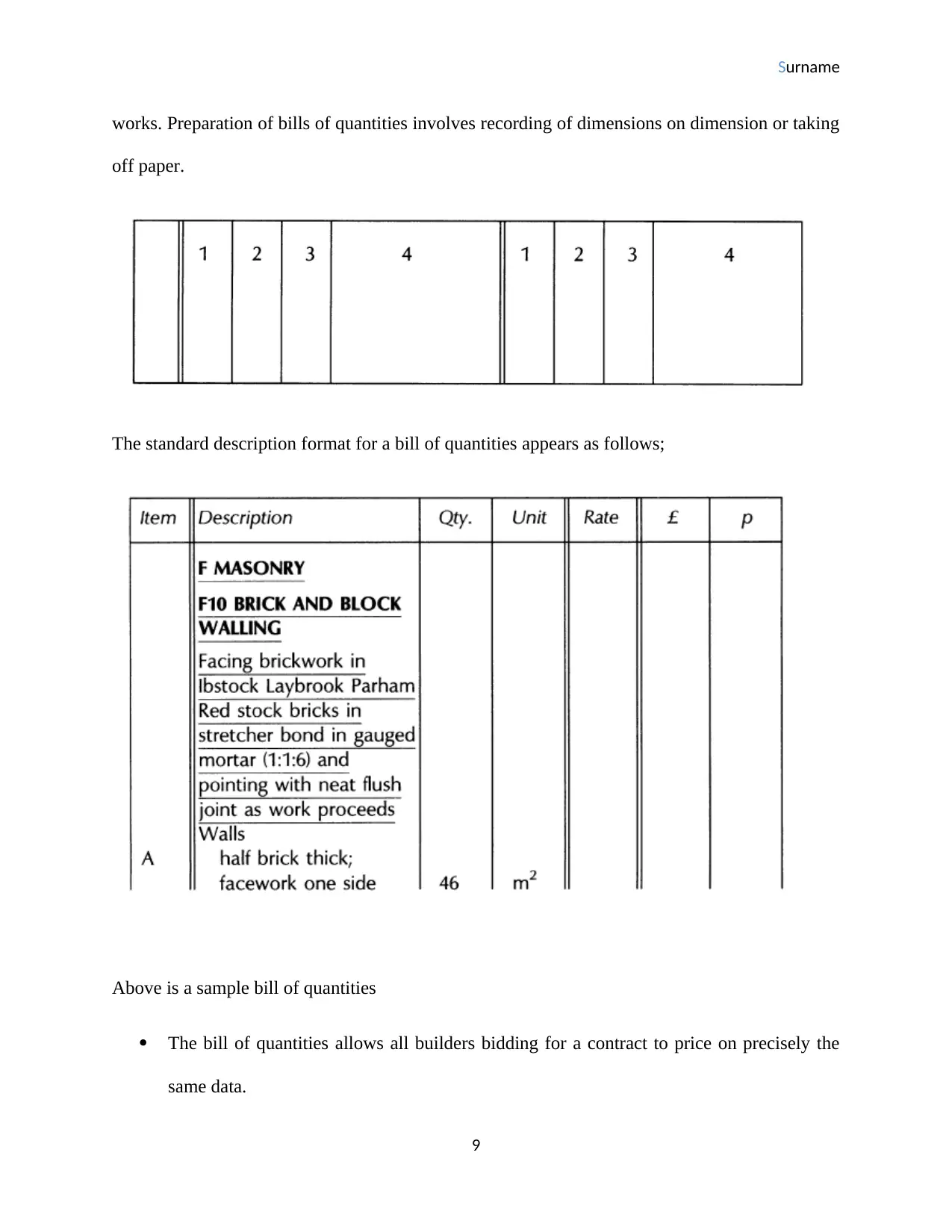
Surname
works. Preparation of bills of quantities involves recording of dimensions on dimension or taking
off paper.
The standard description format for a bill of quantities appears as follows;
Above is a sample bill of quantities
The bill of quantities allows all builders bidding for a contract to price on precisely the
same data.
9
works. Preparation of bills of quantities involves recording of dimensions on dimension or taking
off paper.
The standard description format for a bill of quantities appears as follows;
Above is a sample bill of quantities
The bill of quantities allows all builders bidding for a contract to price on precisely the
same data.
9
⊘ This is a preview!⊘
Do you want full access?
Subscribe today to unlock all pages.

Trusted by 1+ million students worldwide
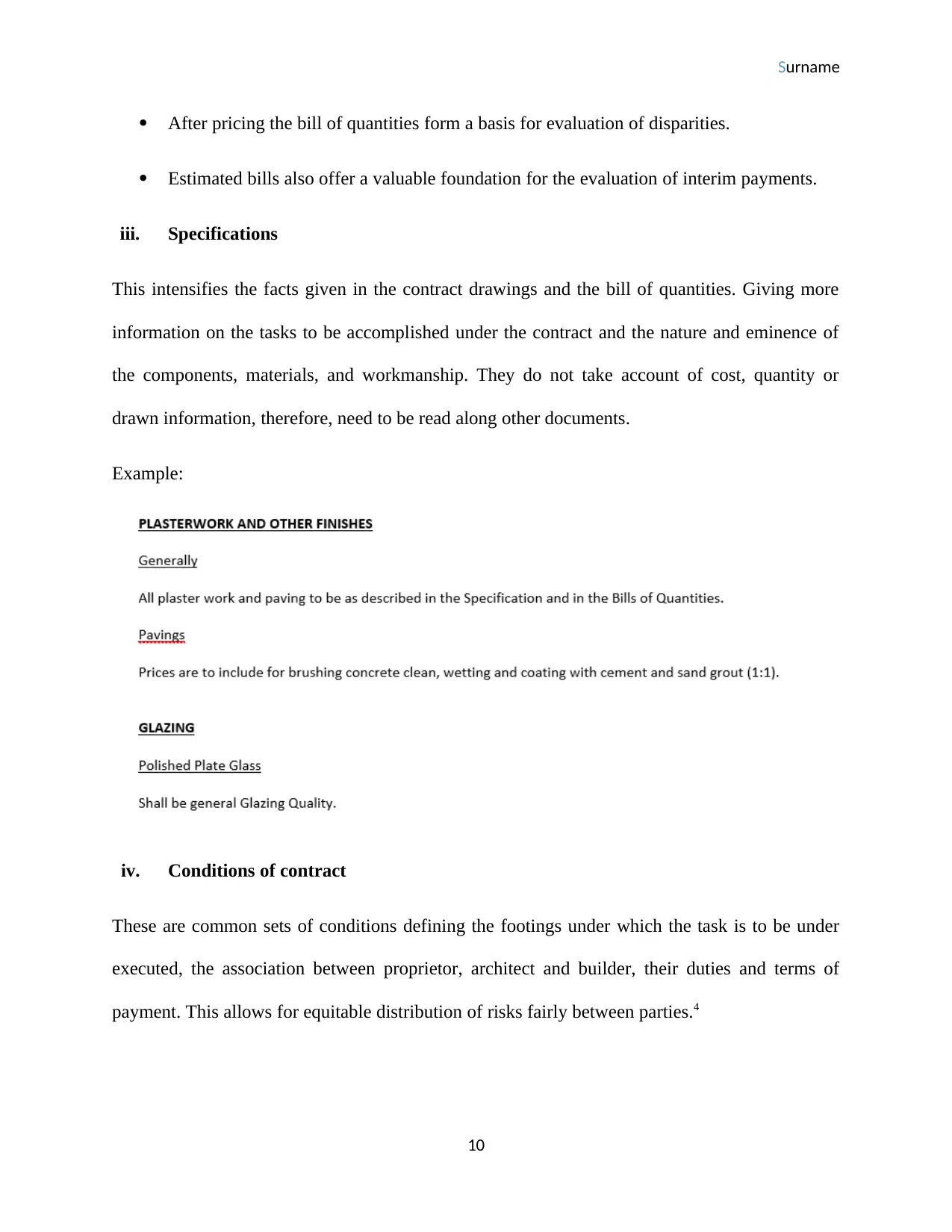
Surname
After pricing the bill of quantities form a basis for evaluation of disparities.
Estimated bills also offer a valuable foundation for the evaluation of interim payments.
iii. Specifications
This intensifies the facts given in the contract drawings and the bill of quantities. Giving more
information on the tasks to be accomplished under the contract and the nature and eminence of
the components, materials, and workmanship. They do not take account of cost, quantity or
drawn information, therefore, need to be read along other documents.
Example:
iv. Conditions of contract
These are common sets of conditions defining the footings under which the task is to be under
executed, the association between proprietor, architect and builder, their duties and terms of
payment. This allows for equitable distribution of risks fairly between parties.4
10
After pricing the bill of quantities form a basis for evaluation of disparities.
Estimated bills also offer a valuable foundation for the evaluation of interim payments.
iii. Specifications
This intensifies the facts given in the contract drawings and the bill of quantities. Giving more
information on the tasks to be accomplished under the contract and the nature and eminence of
the components, materials, and workmanship. They do not take account of cost, quantity or
drawn information, therefore, need to be read along other documents.
Example:
iv. Conditions of contract
These are common sets of conditions defining the footings under which the task is to be under
executed, the association between proprietor, architect and builder, their duties and terms of
payment. This allows for equitable distribution of risks fairly between parties.4
10
Paraphrase This Document
Need a fresh take? Get an instant paraphrase of this document with our AI Paraphraser
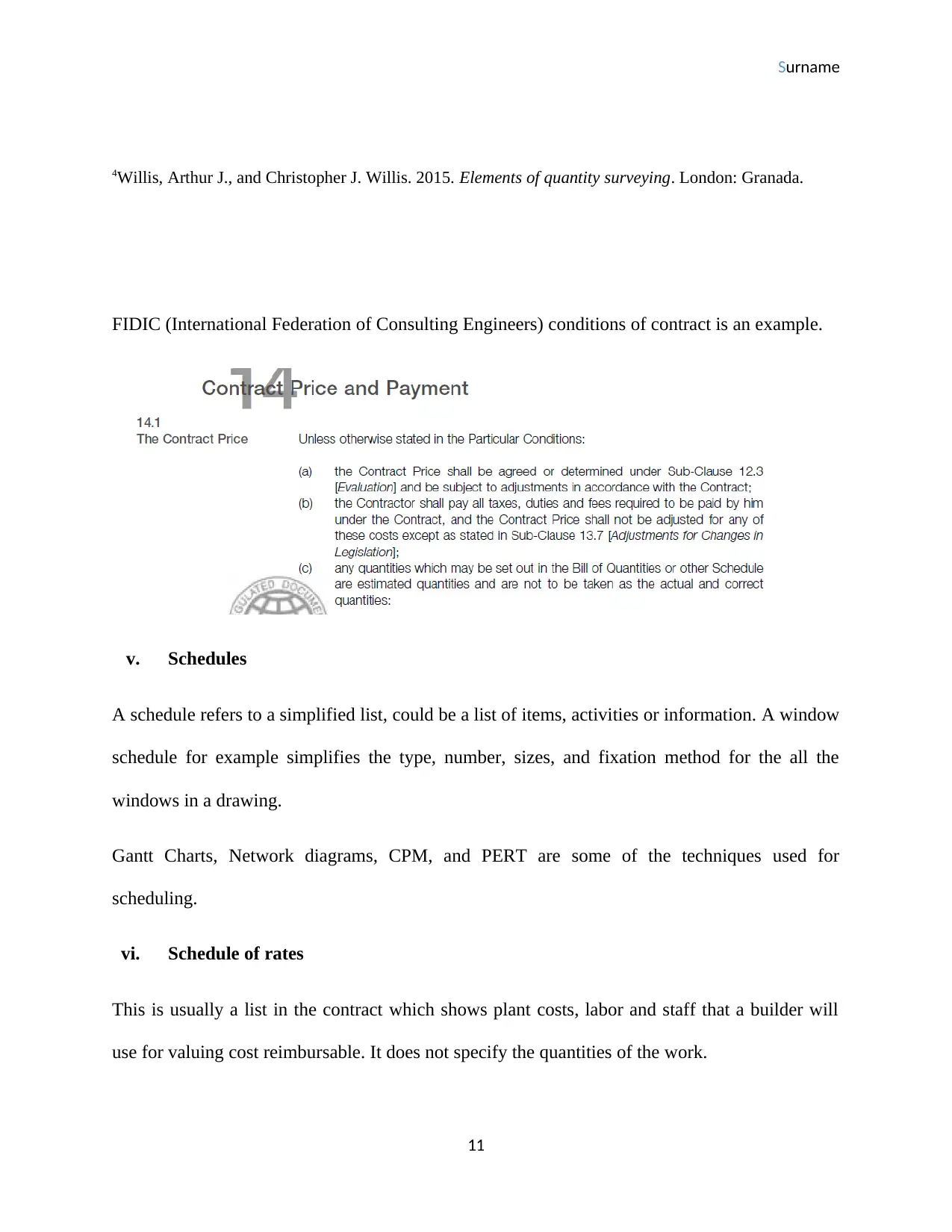
Surname
4Willis, Arthur J., and Christopher J. Willis. 2015. Elements of quantity surveying. London: Granada.
FIDIC (International Federation of Consulting Engineers) conditions of contract is an example.
v. Schedules
A schedule refers to a simplified list, could be a list of items, activities or information. A window
schedule for example simplifies the type, number, sizes, and fixation method for the all the
windows in a drawing.
Gantt Charts, Network diagrams, CPM, and PERT are some of the techniques used for
scheduling.
vi. Schedule of rates
This is usually a list in the contract which shows plant costs, labor and staff that a builder will
use for valuing cost reimbursable. It does not specify the quantities of the work.
11
4Willis, Arthur J., and Christopher J. Willis. 2015. Elements of quantity surveying. London: Granada.
FIDIC (International Federation of Consulting Engineers) conditions of contract is an example.
v. Schedules
A schedule refers to a simplified list, could be a list of items, activities or information. A window
schedule for example simplifies the type, number, sizes, and fixation method for the all the
windows in a drawing.
Gantt Charts, Network diagrams, CPM, and PERT are some of the techniques used for
scheduling.
vi. Schedule of rates
This is usually a list in the contract which shows plant costs, labor and staff that a builder will
use for valuing cost reimbursable. It does not specify the quantities of the work.
11
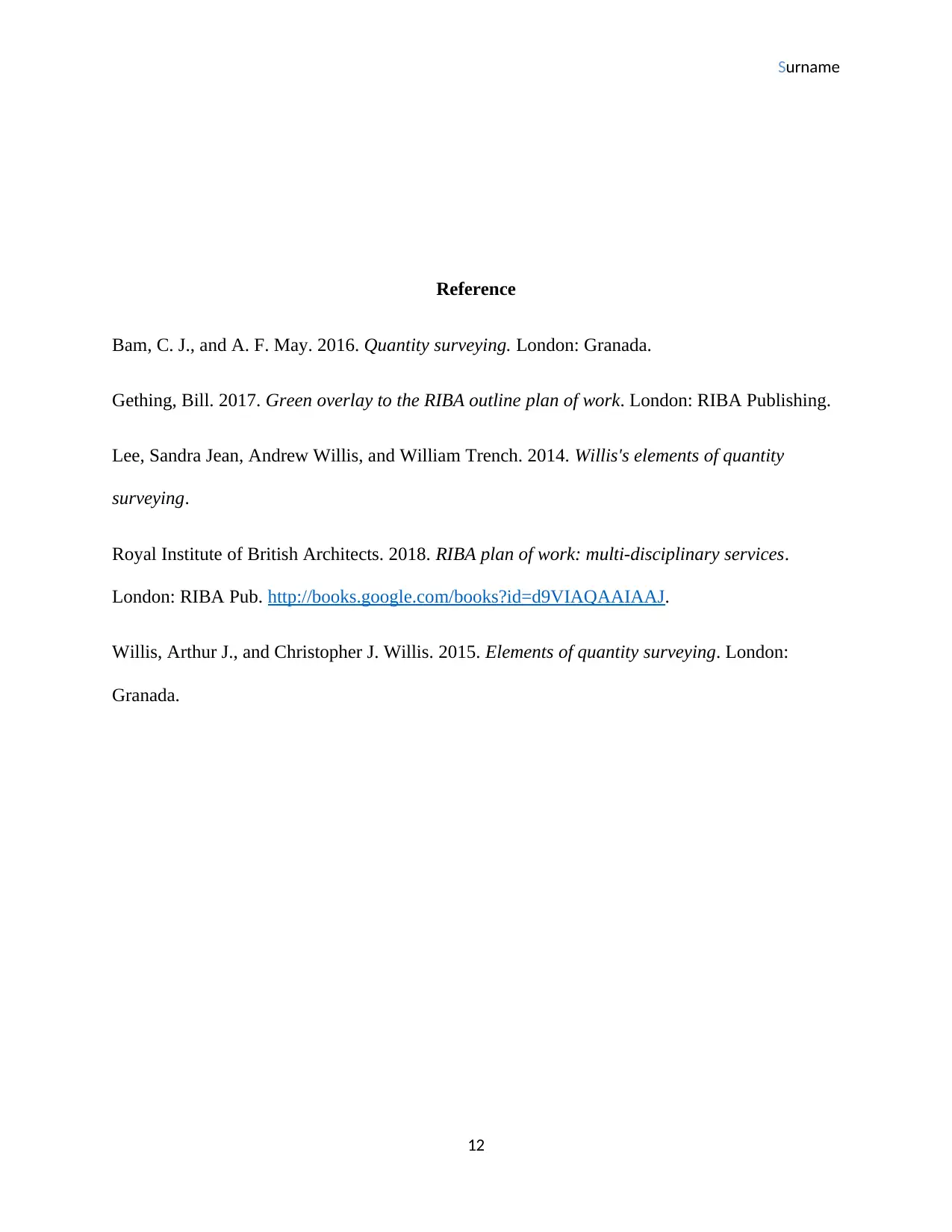
Surname
Reference
Bam, C. J., and A. F. May. 2016. Quantity surveying. London: Granada.
Gething, Bill. 2017. Green overlay to the RIBA outline plan of work. London: RIBA Publishing.
Lee, Sandra Jean, Andrew Willis, and William Trench. 2014. Willis's elements of quantity
surveying.
Royal Institute of British Architects. 2018. RIBA plan of work: multi-disciplinary services.
London: RIBA Pub. http://books.google.com/books?id=d9VIAQAAIAAJ.
Willis, Arthur J., and Christopher J. Willis. 2015. Elements of quantity surveying. London:
Granada.
12
Reference
Bam, C. J., and A. F. May. 2016. Quantity surveying. London: Granada.
Gething, Bill. 2017. Green overlay to the RIBA outline plan of work. London: RIBA Publishing.
Lee, Sandra Jean, Andrew Willis, and William Trench. 2014. Willis's elements of quantity
surveying.
Royal Institute of British Architects. 2018. RIBA plan of work: multi-disciplinary services.
London: RIBA Pub. http://books.google.com/books?id=d9VIAQAAIAAJ.
Willis, Arthur J., and Christopher J. Willis. 2015. Elements of quantity surveying. London:
Granada.
12
⊘ This is a preview!⊘
Do you want full access?
Subscribe today to unlock all pages.

Trusted by 1+ million students worldwide
1 out of 12
Related Documents
Your All-in-One AI-Powered Toolkit for Academic Success.
+13062052269
info@desklib.com
Available 24*7 on WhatsApp / Email
![[object Object]](/_next/static/media/star-bottom.7253800d.svg)
Unlock your academic potential
Copyright © 2020–2025 A2Z Services. All Rights Reserved. Developed and managed by ZUCOL.





